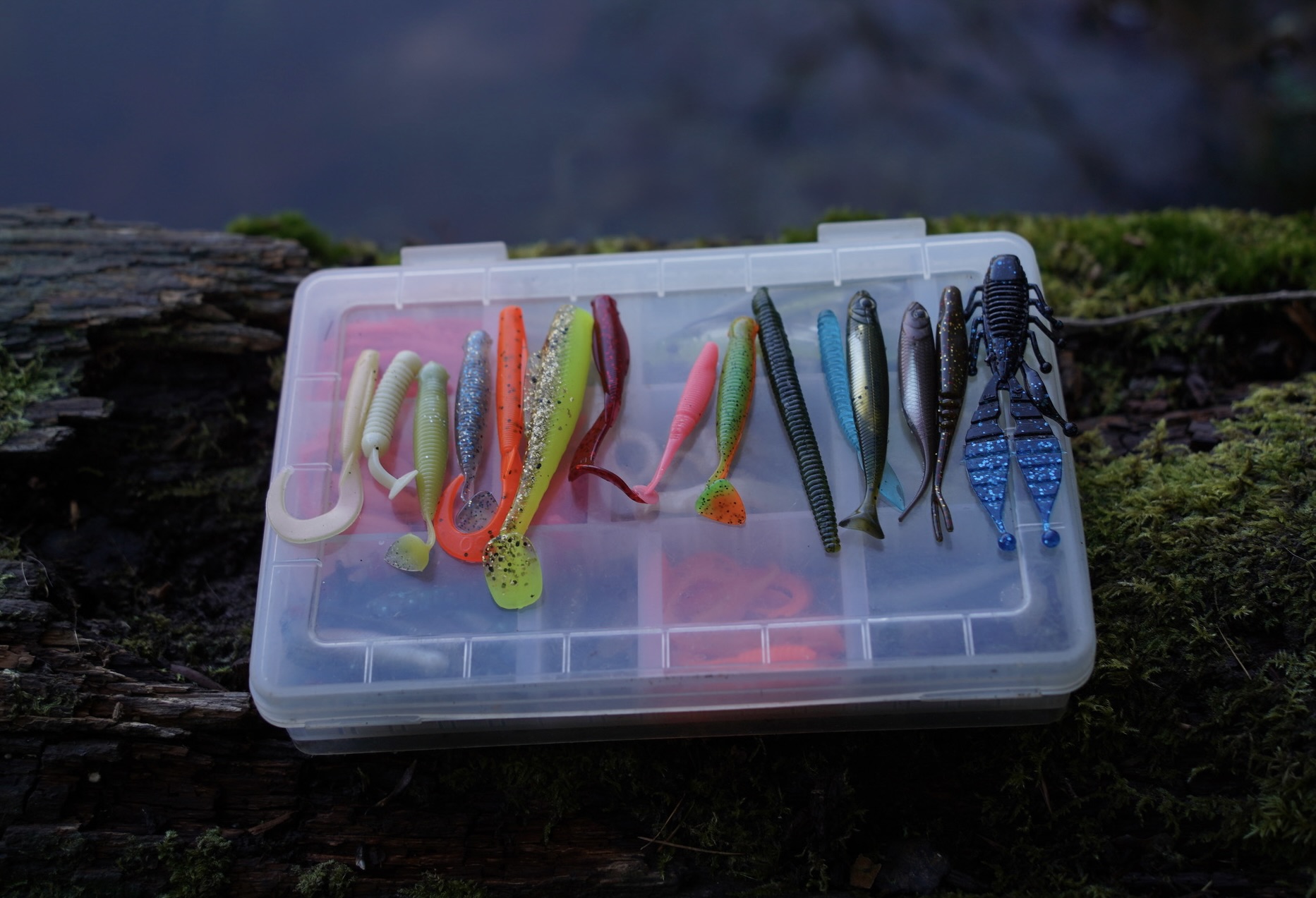
Best brown trout lures UK
Let’s go through every type of brown trout lure and highlight the best trout lures for UK anglers. Brown trout behaviour and feeding preferences vary depending on the water you’re fishing. The challenge of lure fishing for trout is to find the ‘pattern’ that works on the day. I have been fortunate to target these fish in the UK and New Zealand, and this is what I have learned.
Fishmag is reader-supported and earns commissions from affiliate sales, such as from amazon.
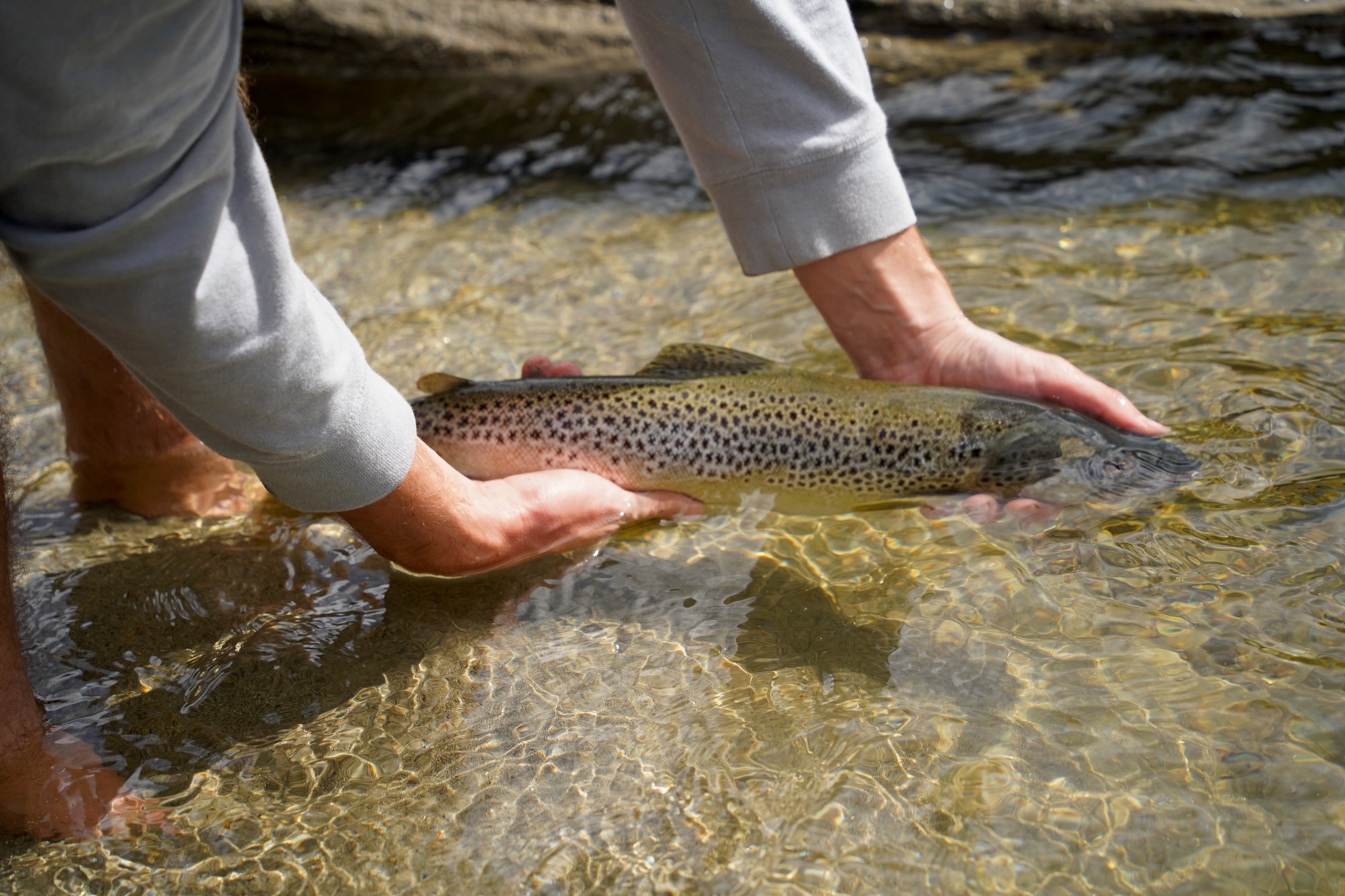
The trout lures that work best for you will depend on your rods casting weight
There are two main types of trout rod for spinning. First, there are traditional spinning rods that cast up to 30-40g. Then, there are ultra-light trout rods that cast up to about 15g or less.
The first of these two rods is far more common. It’s what you need for river fishing for sea trout. This has the grunt to be able to stop fish from running down river. A good river trout can meander around bends and get you tangled in a tree!
But most brown trout in the UK simply aren’t that big. There are days when even a 30g spinner or 3″ plug is simply going to be too oversized. It can intimidate tentative fish of a larger size, too. Downsizing tackle is essential for best results.
Example entry-level heavier spinning set up for trout
If you have a regular spinning rod and want to use smaller lures, use a drop shot or bombarda rig. This is much better than using heavier jig heads or spinners just so you can cast effectively.
Considerations with a regular spinning rod
You may notice soft lures are not included above. Soft plastics can have some limitations with a setup like the one above. Namely, trout are known for nipping at lures without hooking up. When using a soft plastic paddle tail on a jig head, it’s very common. If that soft plastic is 3″ long and weighs 18g, very few trout hits result in hookups.
Scale down to 2″ soft lure with a 7g jig head and a size six hook. You will find you get a lot more hookups. However, you can’t cast jig heads that light effectively on a rod that casts up to 30g. This is why the recommended lures to buy for anglers using rods rated to 30g don’t include any soft plastics.”
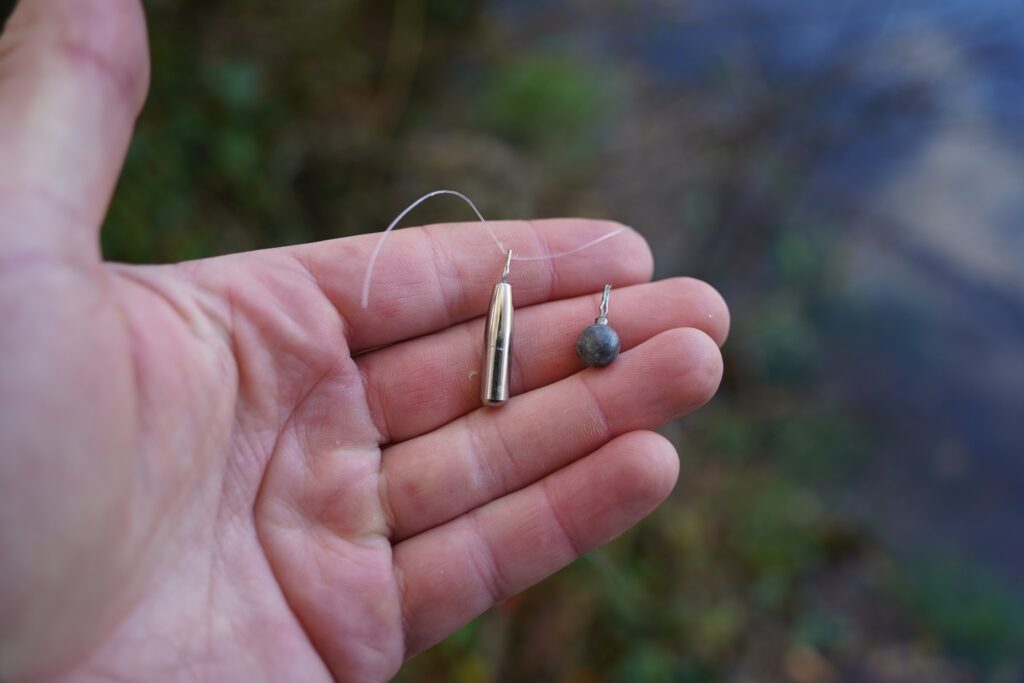
Example ultra light spinning set up for trout
So, a complete set-up might look like a decent light rod, combined with this 2500-size reel, with this 6lb fluoro mainline, with a few Mepps spinners to get you going.
Varieties of trout
A stocked trout in a reservoir is very different from a wild trout living in the stream by your local car park. Sea trout and Ferox trout are different beasts again. Researchers have found distinct trout populations within the same loch or reservoir. They have different morphology adapted to a different food source. This means the selection of lures that can be used is as varied as the diet of these fish. Finding the best brown trout lures requires having a few different lure types to choose from.
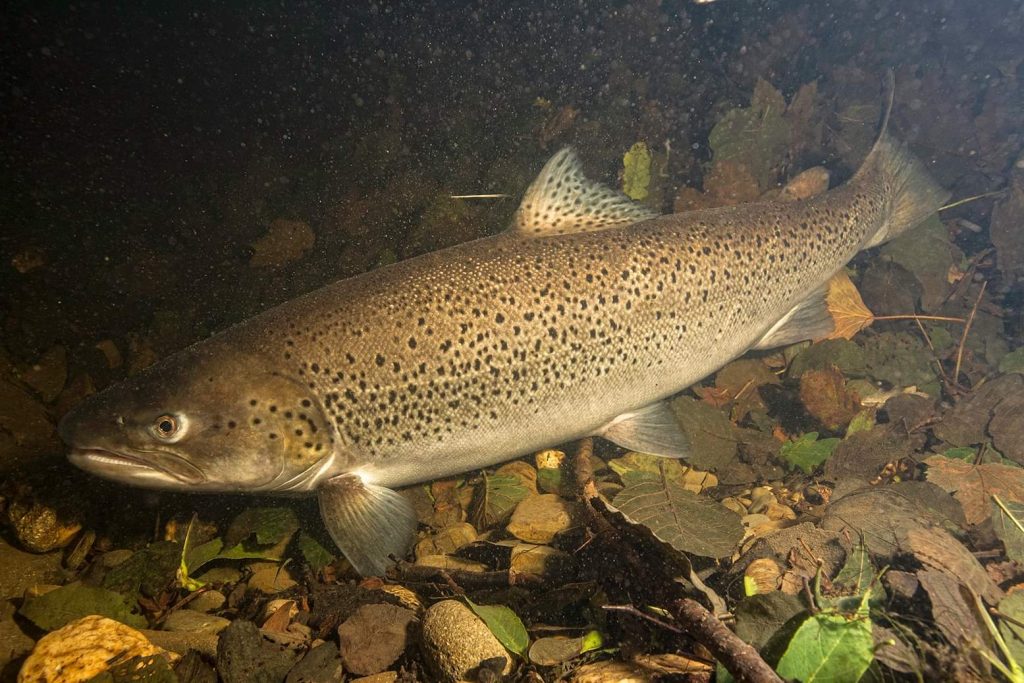
Trout spinners
Metals for trout fishing – spinners to casting jigs
In deeper lakes where some trout will be closer to the bottom, sinking plugs or vibes are effective at getting your lure in the right zone.
When fishing a larger water body like a lake or loch, a 3” sinking hard lure is a great option. If you’re in deeper water or a location with a large body of water to cover, consider using a Japanese casting jig. A casting jig is a modern, fancy version of a spoon or Mepps spinner. The Japanese casting jig performs the same function, but it’s more aerodynamic. This feature allows it to cast further and often sink faster than a Mepps.
As a result, you can search out larger bodies of water more quickly. Small plugs and really tiny spinners present a problem. Even with ultra-light lines and gear, they don’t cast far. This issue is not a problem in a river, stream or small lake. However, it puts you at a disadvantage in larger bodies of water.
Casting jigs for fishing in larger bodies of water
Low cost spinners – also available in a pack here
Major craft casting jigs, very superior but hard to get hold of
Mid-range casting jigs, better than spinners in reservoirs
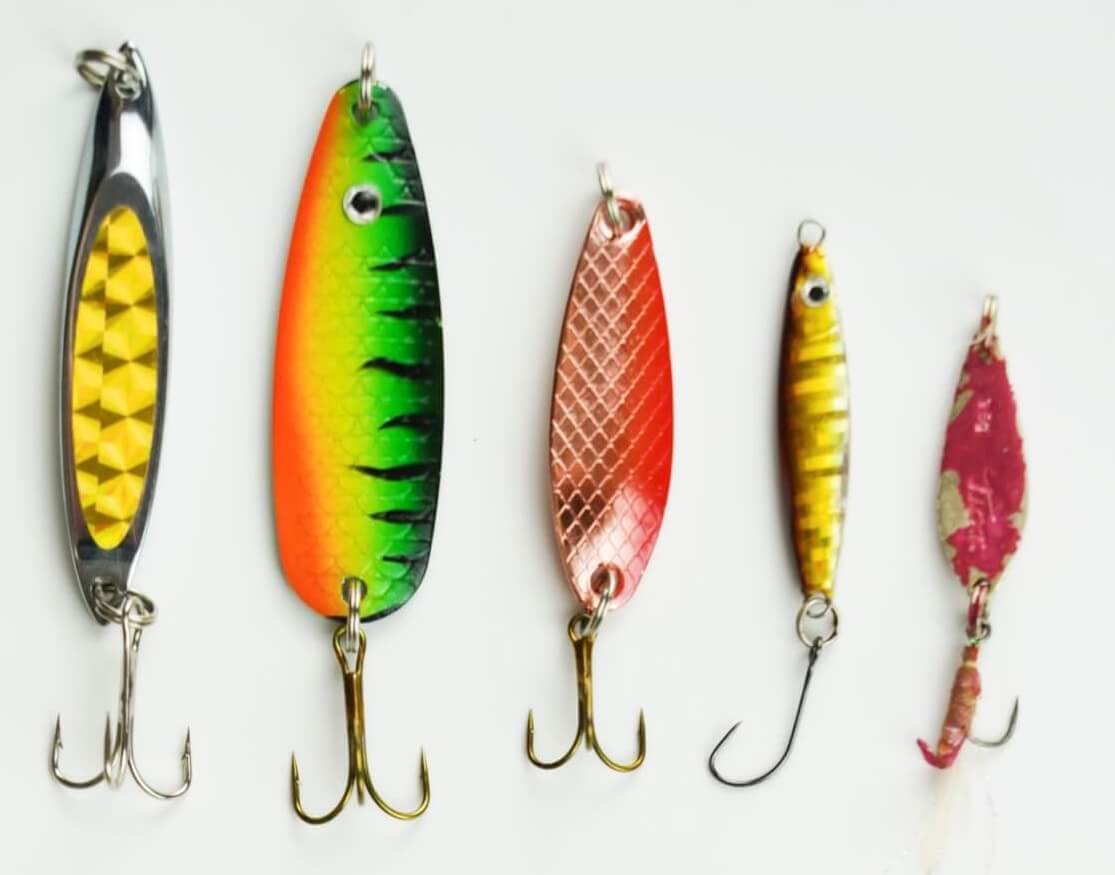
Mepps Spinners
You’ll want some micro spinners for the smaller British streams and some larger spinners for deeper bodies of water where you need your lure to sink into what Americans call the ‘strike zone’ quickly. Many consider the Mepps spinner the best brown trout lure of all time. It’s a nice lure, but I disagree.
Mepps spinners have been a hit for trout since their development decades ago. Variations of that original design are still wildly popular today. There is something appealing about the simplicity of a single spinner that provides its own weight. The flashy presentation and direct lure-to-rod contact this achieves make it excellent for trout fishing. Back in the day a lot of people were fishing with lures with additional weights. This meant there was no direct contact with the lure from your rod tip. The Mepps solved this problem by providing its own weight.
View Mepps Spinner
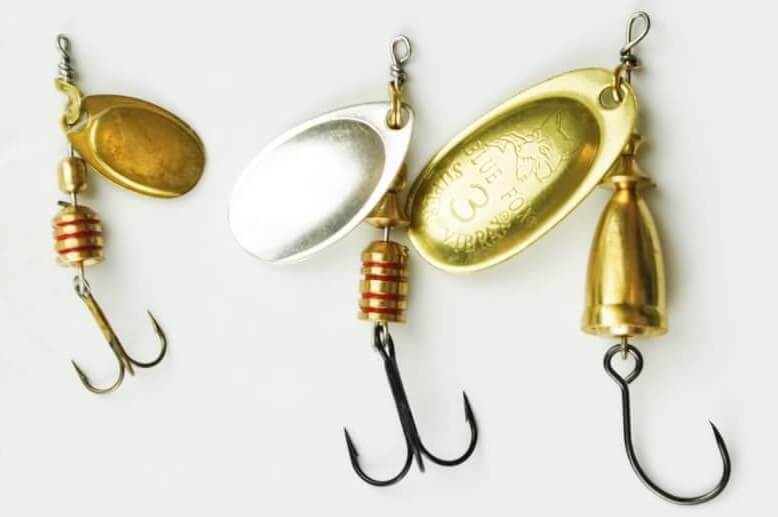
They were originally a French company, with Mepps standing for ‘Manufacturier D’Engins De Precision Pour Peches Sportives’. I think they got bought out by a US company ages ago because the US market is so much bigger.
Reach for a Mepps lure for a timeless classic. They have an aesthetic appeal and history that is unmatched by any other lure. Many now favour modern Japanese hard lures designed for sea fishing. They achieve the same flash but with superior casting distance and presentation.
Trout Spoons
Trout spoons are functional and simple for trout fishing. You can purchase a few in various colours and sizes. Preferably with no added weight, you tie them directly to your mainline and cast them out. As they sink, they flutter down through the water. They appear like a baitfish that another predator has already smashed to bits – easy pickings.

A trout spoon, a classic lure. Grab a few of these for the tackle box, but I don’t think it’s good to rely solely on spoons. They will work best for trout in bodies of water where baitfish are present. Trout expecting to see flies will be less keen on your cutlery!
Not linking to any spoons because there are better alternatives
Vibes
These are essentially metal plates in the shape of a fish that vibrate very rapidly as they’re moved through the water, like a plug. The difference is their profile is completely flat, so they cast much further than a regular plug. Due to the water resistance they create, they’re fantastic on windy days and really piss the trout off. Great lures but stupidly expensive unfortunately so worth reserving for snag-free spots. The lure linked below is different from the one I have used, which is no longer available in the UK.
View vibe
Before we get back to more sensible options again…
Rat imitation surface lures
Yes, Brown trout eat baby mice. If you were to cut open the stomach of a British city trout, what would you expect to find? Some minnows snatched from around a submerged shopping trolley? A black paste of flies? A few cigarette filters? Yes, and, amongst that questionable cuisine, some slimy half-digested baby mice.
There are images online of trout being full with over 20 mice in one fish.
If a sizeable trout sees little pink feet kicking overhead it’s only a matter of time… That mouse is going to find itself Jonah’ed, trapped in a nightmarish pink balloon.
With taste receptors as sensitive as the trouts, I imagine they pick up on the taste of the rat first. The stale fast-food slick the rat leaves behind it in the water. Yesterday’s chicken korma perhaps. Then there is the silhouette of the creature beneath the glow of the city lights.
Fly anglers think trout are graceful classy fish. Let’s not forget the brown trout’s domination of many of the world’s river systems is due in part to being an unfussy eater.
And the Americans know this so our beloved American brethren zealously created a life-size rat lure.
It comes complete with a wiggly, twitchy tail, that can be retrieved edgily over the surface to imitate an injured rat.
The short version is, that these rat lures are too big for trout, but if you manage to find a small one about 2-3” long it could work. Just make sure you use a wire trace because the pike will have it.
Trout plugs
Hard lures give you a really strong contact with the lure. The water resistance they create causes a tension in your line. This is satisfying compared to super light soft plastics which provide less resistance. Plugs also often float, which means you can let them drift downstream with minimal casting disturbance. When fishing streams, you definitely want to be using very shallow diving floating plugs. This way you aren’t scraping and hooking the bottom on your retrieve.
Hook-up rates are also higher with hard lures, but this comes at the price of doing more harm to fish with treble hooks. This is why replacing treble hooks with single hooks is a great thing to do.
My top tip for buying hard lures is not to buy them at all and stick with spinners and soft lures unless you’re paying £7 or more per lure. I haven’t found a cheap and fully functional plug for trout.
Rapala invented the trout plug – they are available here at a more reasonable price than many modern plugs. The main thing to note when buying trout plugs is that for smaller stream trout and most feeding conditions, you don’t really want plugs to be as large as most of those on the market.
IMAX provide a lower cost trout plug here.
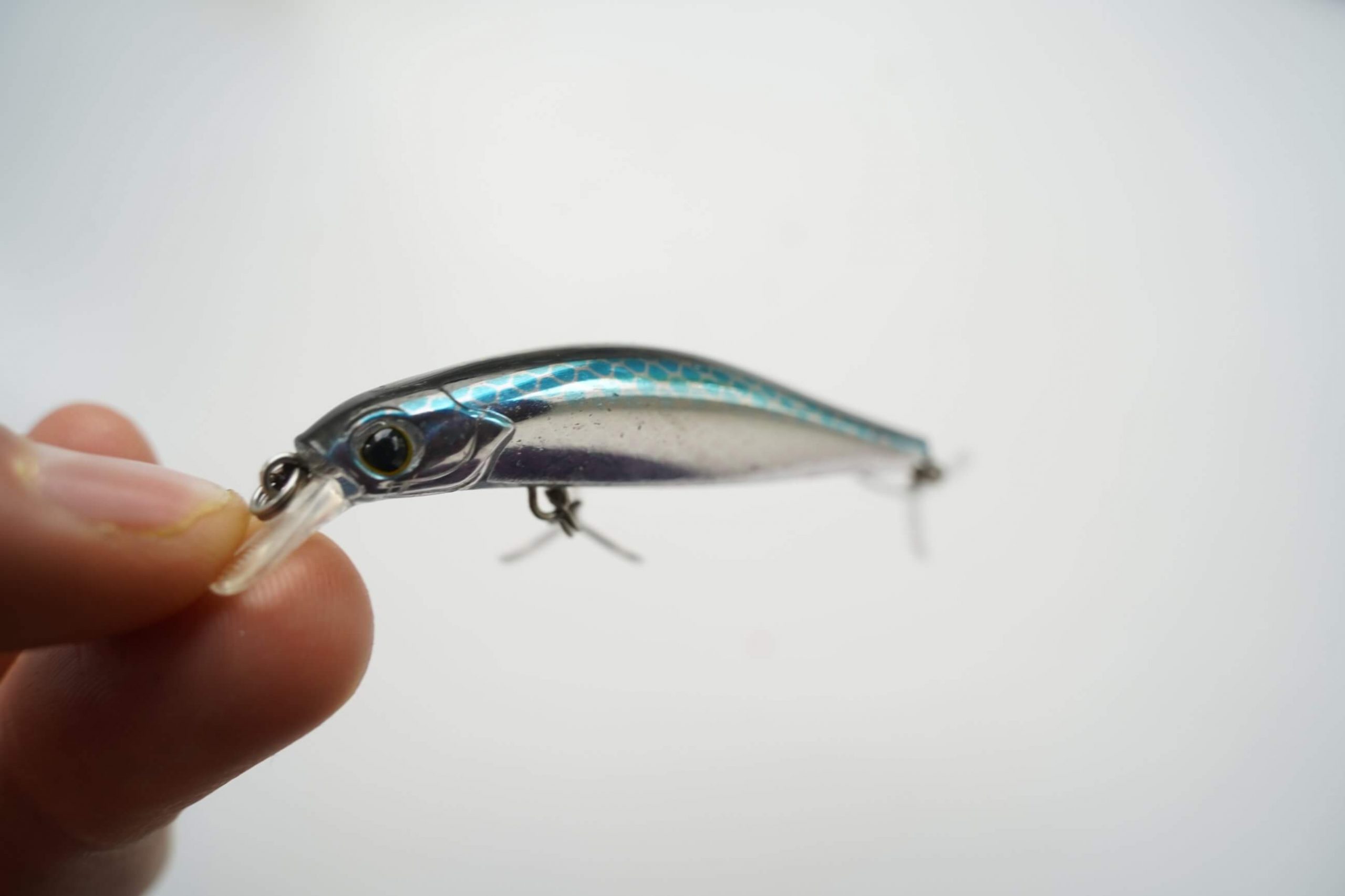
Hard lures and best plugs for trout
Trout are a species that often respond very strongly to vibration and heavy actions in lures. While they’re famous for being wryly fish – cautious and shrewd – it really depends on their mood on the day. Often, trout will venture out further to chase and hit a noisy hard lure.
Trout react to lures with fast wobbling movements. These movements feel like a vibration up through the rod blank. However, some days, these lures may spook the fish. In such cases, you might prefer to try soft plastics first. This approach helps to avoid potentially spooking all the fish with something more aggressive, flashy, and noisy.

Minnows, crank baits & lure size for trout
Poppers are hard lures that typically wobble or vibrate in the water as you retrieve them. They usually come with treble hooks. They are useful for trout fishing in sizes 1 – 4”. I use 1.5” plugs for river and lake trout. The shorter plugs will tend to have fat bodies – in the US they would call this a crankbait. If you’re using a longer plug of 3-4” it should have a slender minnow profile – longer and thinner. This is because a fat 4” plug would spook most British trout. They might use that in the US but those trout have greater appetites…
A 3-4” minnow is effective for larger trout (like Ferox). It is also helpful if you need to cover more ground by casting further in a loch or large lake. Most anglers should reach for 2” plugs, which is a great size for the trout we have in the UK. Tiny stream trout will hit larger lures, but only when they’re in a certain mood.
Sinking vs Floating Trout Lures
You may choose a sinking plug if you’re fishing in a deep loch and want your lure to reach the depths or when trolling from a boat. On the other hand, you’ll need a very shallow diving floating plug for streams and rivers. The floating plug is beneficial because it allows you to let the lure drift downstream in the current. This way, it can reach places that are inaccessible by casting. The plug needs to float to enable you to control the depth and prevent it from scraping along the bottom of the stream.
So far, in our tackle box, we might have a few short and fat 1.5” crank baits in various colour patterns and some 2” and 3” slender minnow profile trout plugs, too.
Poppers & surface lures
For more experimental anglers, you should grab some little poppers as well. Trout are acrobatic surface feeders. They will not turn their noses up at a well-presented surface lure, twitching and spitting over the surface. Big trout take overambitious fledglings off the surface, as well as baby rats and a myriad of insect species. It is hard to buy lures in the UK that are small enough to be appropriate for surface fishing for trout. You really need the popper to be 2” and preferably with a slender profile.

When the first brown trout moved into the river systems in the UK after the ice age, those rivers were empty. There were no other fish in there, or at least there wasn’t a fully developed ecosystem like we have today. Those early trout likely lived on whatever fell into the rivers from the river banks – mostly insects. There are plenty of places where they only eat insects, and there are places where the trout grow huge eating only flies.
Soft plastics for trout
Soft plastic lures
Soft plastics are lures that have soft bodies made from plastic. Usually, they come unrigged without hooks. The fish minnow is the best-selling soft plastic. In its smallest size, it proves deadly for all manner of British freshwater species, including the trout. However, I would advise against using weedless hooks with trout. Trout can be tentative feeders and weedless hooks won’t assist you in achieving hookups.
Jig heads in a range of sizes, under 10g is best if your rod is light enough, size 4-8
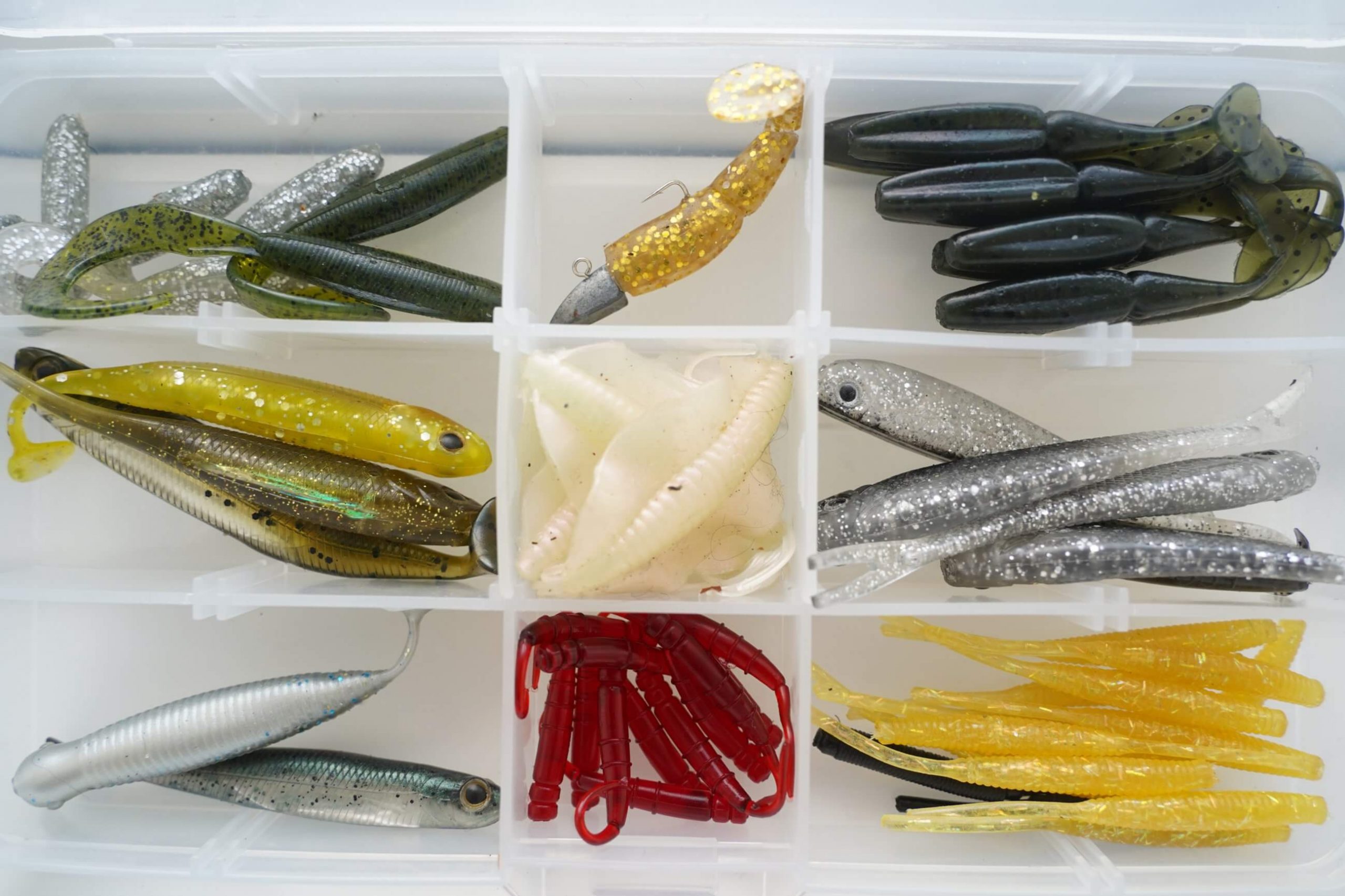
Instead, reach for the sharpest jig heads out there. Stick to using paddle tails or straight tails and ignore curly tails, which are better as Perch lures.
For most river and stream trout I would recommend 2” soft plastics rigged on LRF jig heads. If you can’t fish this light, they reach for spinners instead and forget soft plastics. An oversized soft plastic is a recipe for zero hookups and two dozen hits.
If you are fishing in water known to hold larger fish or if you need more distance in your cast, then reach for a 3-4” soft plastic with a modest-sized hook, preferably sat further back on the lure.
Advantages of soft plastics for trout
Small soft plastics rigged on ultra light jig heads are great. They allow you to swap out your lure body very quickly to mix up the colour. For instance, consider a scenario where you’ve hooked and lost a trout. If the fish become unresponsive, having the ability to quickly change colour is handy. You can try again to see if you can tempt them again. Soft plastics have just one hook, which minimises damage to fish you intend to release. This is in comparison to treble hooks. Most plugs and spinners use these as a standard.
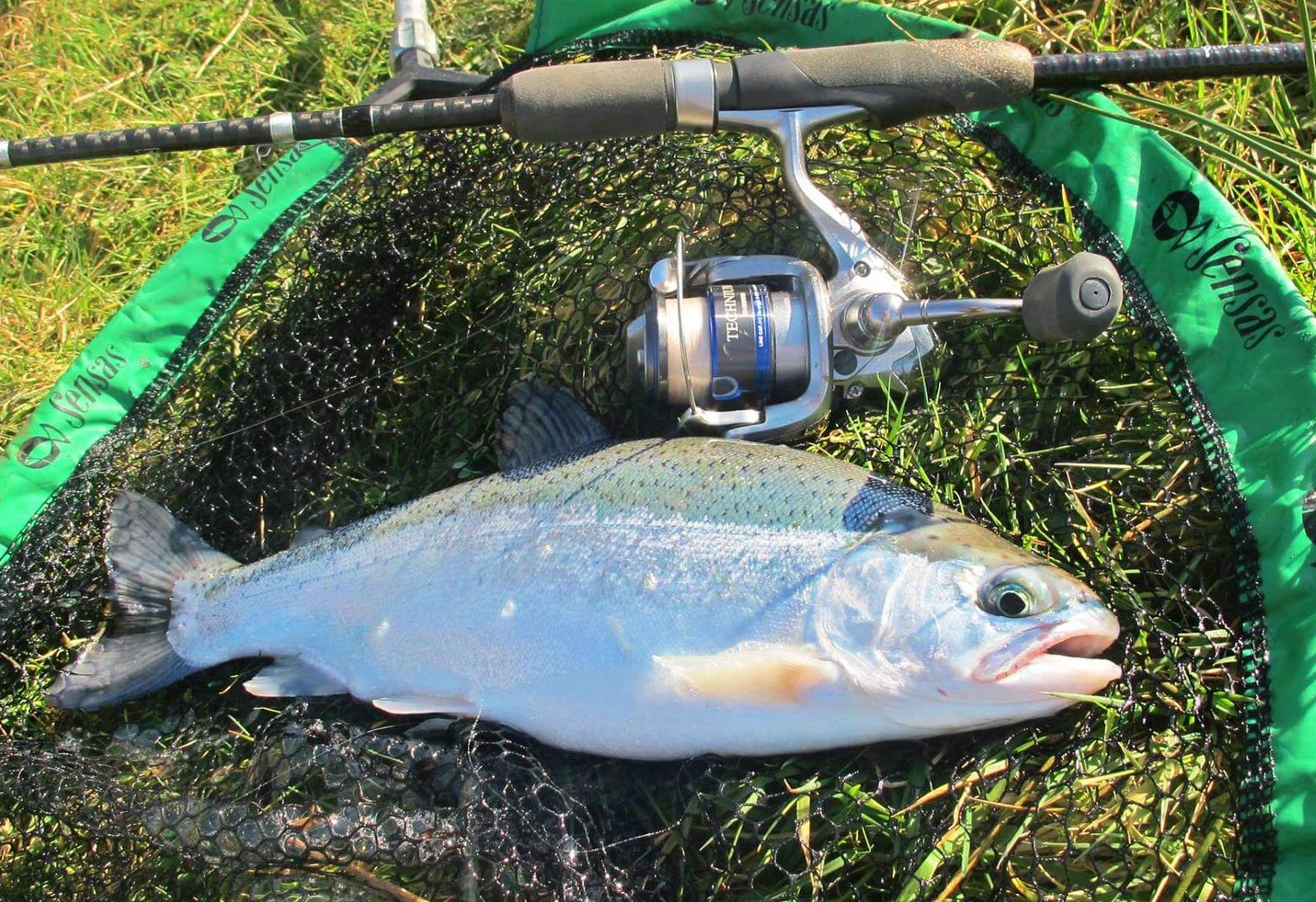
When using soft plastics, you may hook fewer fish, even though you get as many takes as with a hard lure or spinner. The hook’s position causes fewer hookups. Trout often nip at the lure’s tail or swipe the lure to disorient it. This can be frustrating or tantalising. However, I prefer this method for catch and release fishing.
Soft lure actions for trout
Paddle tails and straight tails are best. It probably isn’t hugely important what the action of the soft plastic is – the main thing is the hook positioning and size of the lure. You want the lure to be small and the hook further back. As always, you’ll need a pair of disgorgers to easily unhook the fish and return them quickly.
Jig heads for trout
Use jig heads as a great tool in yourtrout arsenal if you are using LRF gear, ultra light game tackle, or a rod that casts under 20g. You can find them here. However, if you lack this more specialist kit, avoid them. Super light lines and rods are necessary to fish them effectively. Avoid jig heads if your hook size exceeds size 4 or weighs above 7g at maximum. To cast these lures effectively, you must have a lighter rod. If you don’t have an ultra-light rod, spinners are the best choice.

Grab a range of jig heads with hook sizes from size 4-8 and weights of 1-5g. If you need to cover lots of ground, jigs heads may not be the best option. You’ll be forced to use heavier weights than is optimal to achieve the casting distance required. If you’re fishing a water for sea trout or ferox trout, some of the pre-rigged soft plastics aimed at sea anglers would be effective.
Trout tend to hit soft plastics without getting hooked. Therefore, fishing with very small soft plastics is generally better. Consider the size of the flies that fly anglers use for this species. They are quite small.
When fishing with jig heads for trout, you’re likely to get far more hits than you do hookups. To avoid this problem, use long shank jig heads with hook points further back on the lure if you can.
Trout egg lures & more
Trout flies with regular spinning gear
Flies allow you to imitate one of the trout’s favourite food sources – insects. There are bodies of water with no bait fish where the trout grow huge just on flies. As a regular lure angler not using fly gear, how can you benefit from the finesse of a well-presented fly?
The bombarda rig
This rig allows you to cast very light, small lures long distances and plumb the depths easily. The method involves the use of a bombarda. This is a clear, transparent weight that is aerodynamic and moves through the water with minimal resistance and disturbance to fish. This acts as an invisible weight. The lure, which will be a small lighted weighted fly – perhaps 2-5g – then goes at the end of a long leader. Longer is better for lure presentation. Some use as long as 9ft, but this isn’t necessary if you aren’t able to fish with that much leader as casting does become trickier.
Your lure can’t achieve the same finesse in presentation as a fly angler can, because it can’t drift in a current in the same way. However, fishing with a lure as subtle as a fly proves very handy, and grabbing a few bombardas allows you to do this. Most commonly, anglers use this method in Scotland for sea trout in the sea. This method could also work well in large but highly pressured lakes. In such environments, it’s beneficial to cover lots of ground to seek out the fish. However, you wouldn’t want a larger lure that might scare off highly pressured fish.
Worm & Egg Imitations
I know worm imitations well and recommend them for a wide variety of species. However, I’ve had no success with trout. I believe they would work. After all, trout do eat worms. Yet, they are somewhat impractical. This is because they are often quite soft-bodied. When trout strike but fail to hook up, you would need to constantly tie on new worm imitations. As for the egg imitations, using these with Light Rock Fishing (LRF) tactics could be fun.
It could be part of a freshwater species hunt. This is because you could target species that rarely or never usually take a lure. These imitations don’t allow for a very active style of fishing. However, they could be effective in very cold water. This is where the trout’s metabolism has dropped to the point that they’d prefer to eat an egg rather than chase a lure. I haven’t fished with these, so I can’t comment on their effectiveness. I do know however that the worlds biggest rainbow trout, which feed on the food that falls down through the salmon farm nets in Lake Tekapo, New Zealand, are best targeted in this manner. I suppose they are accustomed to not having to work for their food!
Earth worm imitations available here
I would be more inclined to use a ball of grey fluff with a bottle cap and half a wine cork.
Trout Lure Q&A
Get in touch with any trout lure questions at [email protected], I’d love to help you find the right lures for your local waters.
The tackle you need to fish with light trout lures
It’s impossible to talk about the best trout lures without talking about the rest of your tackle. That’s because in order to use lures this small, we must use a light rod and reel set up and very light lines. Otherwise, lures of this size cannot be cast effectively and you won’t have good contact with your lures.
What casting weight trout rod should you get?
The short version: get a rod that casts no more than 30g (10g is great for stream and lake trout that cannot run down river), use 6-8lb braid and a long 4lb fluorocarbon leader and if you don’t know how to tie a leader knot, use the 4lb fluoro as mainline which is also great. You can read more about choosing a lure rod, spinning reel and braided line in Fishmag’s complete guides.
It’s useful to use bigger lures to get attention or plumb the depths in lochs for Ferox trout or for sea trout, but even then we’re talking about a 3-4” lure.
We will begin with the classic trout lures and then explore when and where each lure type works best. This article will also cover the natural food sources of trout and how anglers can imitate each of them as well as a breakdown of the categories of brown trout lure and when to use each kind.
We want to imitate things that trout want to eat, so what do they want to eat?
As discussed in our brown trout guide, these fish eat different things depending on which ecological niche they occupy. Some fish specialise in eating insects, others zooplankton, others other fish. In Scottish lochs where studies have been done, the trout have completely morphed their appearance to fit to adapt to eat of these food sources, so within the same lake or loch, you have 3-4 different types of trout with different feeding habits.
Trout do not have eyesight as sharp as ours. They will see your lures as blurred-out objects, which means the size, form and movement of the lure will matter most.
You could buy 100 lures and still not reflect the variety present in the natural diet of the brown trout. The key to understanding this species is to know that they are eating in the water you’re fishing.
What are the best trout lures for UK lure fishing?
If you’ve read the guide to trout fishing in the UK, you’ll know that I don’t think it makes sense to think of brown trout as one type of fish. A stocked lake trout hand raised by humans living in a deep water reservoir is very different from a small wild trout in a little stream behind your local Asda car park. Sea trout are a different creature again, as are Ferox trout with those huge mouths in those Scottish lochs, which behave more like pike!
However, what remains the same is that trout are predatory fish and eat a wide range of types of food. Fish eggs, small voles, overambitious hatchlings, small fish, fish eggs, other trout, insects and of course, flies. What’s interesting is that while you might imagine the larger brown trout prefer larger lures, this is not necessarily the case. Think of how fly anglers use tiny fly imitations and catch large trout that way. If you’ve ever fished with a larger crankbait in a stream, you’ll know that some of these small trout have eyes far larger than their tummies. In general, you’re going to increase lure size with the size of the fish you’re targeting, though.
What size lures to use for brown trout?
Trout vary hugely by size depending on where you’re fishing, but huge trout eat tiny flies and smaller trout can be shockingly ambitious. Other factors, like how aggressively the trout are feeding that day, will have a bigger impact on the best lure size for brown trout that day. An online trout guide recommends that anglers generally start with smaller lures – about 2 inches – and work their way up to 4” lures if those fail. The idea is to not spook the fish with larger lures at first, as you can always try larger lures after a few casts with a less intrusive presentation. He also recommends the use of larger lures in murkier water or when you need to cast further in lakes.
When to use plugs vs soft lures for trout
My experience with brown trout has been that some days they are wild for small plugs with heavy vibrating actions. They will often strike these again and again if they aren’t hooked the first time. However, on other days small soft plastics of about 2” with very thin profiles work well when trout are spooked by plugs, though the takes are often more tentative when they do hit. If the body of the soft plastic lure is too thick and you are fishing with a single hook sat on top of the lure, the trout may struggle to get it in its mouth. You will get lots of hits with few or no hookups. I prefer lures with a thinner profile and size 8 razor-sharp single hooks.
Increasing hook up rates with 5g jig heads
The use of small jig heads that weigh under 7g, 2” soft plastics and LRF rods which cast up to 10g are best. A 1000 or 2500-size reel with 3-4lb fluorocarbon is best for not spooking the fish since braid in clear water will be visible to fish even if you use a leader. This is an extremely light and delicate way of fishing. If you’re fishing in a river for migratory trout this setup will be too light and you are likely to struggle to bring a trout in without an unreasonably long fight. The trout may just take you down the river and a meandering line is likely to end up tangled. For these fish, I’d reach for a rod rated to more like 21g-28g which is 1 ounce. Still a very light rod.
What colour lures for UK brown trout?
Natural-coloured lures that reflect the colours of the trout’s environment are popular. Silver, dull browns, oranges etc can all work well. The more extreme US-style lures with bright greens, black stripes and vivid oranges are too ‘hype’ for many anglers liking in the UK.
How do trout see our lures?
The scales of a trout under a microscope have a similar appearance to a tree stump. There are growth rings all the way into the centre of the scale, where layers have been added to the outer edge of the scale throughout the trout’s life. Even on some of the scales, there are tiny black spots.
Even once the trout have survived that long, they still aren’t necessarily going to get laid. Trout select mates based on the appearance of health and the scent/taste of the opposite sex fish.
Fish with smaller lures first
One method for doing this is to start out by fishing with smaller lures with a more subtle presentation, casting upstream first (so you don’t spook the fish by retrieving a lure up behind them, and because they face upstream) and then only moving onto larger lures if this fails to get attention.
Depth and retrieval speed are more important than lure choice
Choosing lures for river trout vs stream trout
More food = bigger fish
But when trout hatch in isolated bodies of water, they will stay there and thrive, developing different habits to match the water they are in. Trout will grow to the size their diet allows for, so if a trout is feeding on insects that fall into a 1m wide stream, they often grow to 6”. If they live in a waterway in a city, where baby rats swim over the shopping trolleys and who-knows-what below, they get much bigger.
The size trout grow to is determined by food availability divided by the number of trout in the body of water. It’s just about the size of the water. For example, there are small bodies of water in New Zealand where there are salmon farms. The trout there feed on the bits of food that fall down through the salmon cages and grow to monster sizes, even though the water body itself isn’t huge. In a Scottish loch with loads of baitfish, you will find more monster trout.
2″ Lures Often Best for Trout
The largest fish are sea trout that have returned to rivers to spawn since these have been eating other fish. Insect larvae are always on the menu, regardless of size. For this reason, you don’t have to use bigger lures for river trout than you would for stream trout. Lures around 2” are great for trout of all sizes, including the smallest and biggest fish. However, there is something appealing about scaling tackle down to tiny spinners and micro plugs for stream fishing.
How trout conserve energy & implications for lure choice
Trout want to conserve their energy, eat good food and, in waters that are heavily fished by catch-and-release anglers, avoid getting hooked. This is why you will often find them lingering in the pockets of water and gulleys where there is less water movement (but still some), on the edges of an area with a stronger current. This allows them to spend little energy swimming while benefiting from a literal stream of food coming straight at them.
For trout to survive they must conserve energy efficiently and get enough food without being eaten themselves, 95% fail at doing this in their first year, and about half die each subsequent year after that. The ones that survive are smart fish.
In water with temperatures that are a bit too low or too hot for the trout’s liking, you may find the trout are feeding less actively. In these conditions, it may be worth taking a leaf from the fly anglers’ book and reaching for delicate fly imitations that can be fished very passively for drowsy fish and preferably dropped right in front of them with finesse.
US Trout Fishing VS British Trout Fishing
Lure fishing for trout in the US is huge, and much of the investment in lure development comes from US-based companies. What does this mean? It means much of the discussion and design of trout fishing lures is aimed at US anglers.
To start with, the native trout in the Pacific is the rainbow trout, which are generally considered to be easier to catch than brown trout. Even when they are targeting brown trout in the US, their fish are feeding on a different set of species to ours. They won’t behave in exactly the same way as UK brown trout, and so the lures will be a bit different.
Fishing scenes in different countries can be quite insular, but we can pick up tips from the way they fish over in the US even though the styles may differ at times. For instance, the P-Wee Trout Worm rig is a pretty nifty way of avoiding getting nips at the tails of your soft lures that don’t result in hookups.
Can you cast flies with a spinning rod?
We as lure anglers using fixed spool reels and mostly sinking lures, need to deploy methods with more finesse if we are to successfully imitate a fly on the surface. While it’s possible to do this, it’s probably best to just reach for a fly rod if you want to imitate flies. With a spinning outfit for trout, we can very effectively imitate a small injured baitfish on the surface, and if the plug is small enough, perhaps a large, unusually splashy beetle.
Seeing trout take a fly from the surface of a river or lake is a common sight. There is a wriggling morsel, drifting gently in the river current, or sitting on the golden surface of water in that last hour of daylight. Moments later, there is a splash, and then there are only ripples. This feeding behaviour inspired the development of fly fishing. It’s hard to fish flies on the surface with a regular spinning rod, but you could try with split-shot and a floating fly.
What size popper for trout?
Large poppers (anything over 2” really) were designed for the US bass fishing scene or for pike. Fishing for trout with a very small surface lure is extraordinarily fun, but surface lures of under 2” are pretty rare in UK tackle shops. Avoid anything larger than that.
What is a tenkara fly rod?
The most appealing approach to fish for small stream trout in the UK is with a tenkara rod. This is a rod that comes without a reel and is cast like a fly rod. It’s extraordinarily lightweight, so even the 5” brownies we have lots of in the UK put up a fight. This set-up allows you to present very small lures in a graceful manner.
